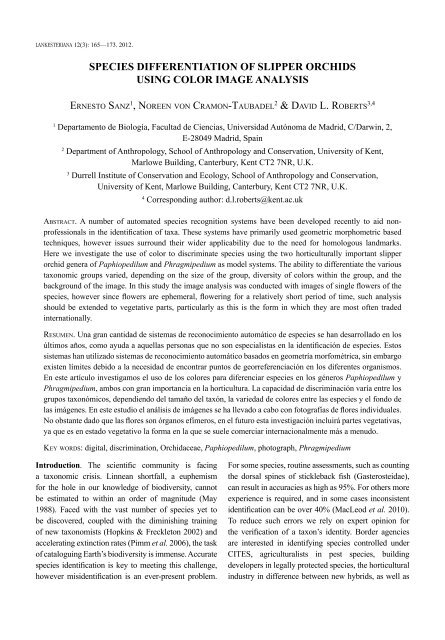VOL. 12, No. 3 - lankesteriana.org
VOL. 12, No. 3 - lankesteriana.org
VOL. 12, No. 3 - lankesteriana.org
Create successful ePaper yourself
Turn your PDF publications into a flip-book with our unique Google optimized e-Paper software.
LANKESTERIANA <strong>12</strong>(3): 165—173. 20<strong>12</strong>.<br />
SPECIES DIFFERENTIATION OF SLIPPER ORCHIDS<br />
USING COLOR IMAGE ANALYSIS<br />
erneSto Sanz 1 , noreen von Cramon-taubadel 2 & david l. robertS 3,4<br />
1 Departamento de Biología, Facultad de Ciencias, Universidad Autónoma de Madrid, C/Darwin, 2,<br />
E-28049 Madrid, Spain<br />
2 Department of Anthropology, School of Anthropology and Conservation, University of Kent,<br />
Marlowe Building, Canterbury, Kent CT2 7NR, U.K.<br />
3 Durrell Institute of Conservation and Ecology, School of Anthropology and Conservation,<br />
University of Kent, Marlowe Building, Canterbury, Kent CT2 7NR, U.K.<br />
4 Corresponding author: d.l.roberts@kent.ac.uk<br />
abStraCt. A number of automated species recognition systems have been developed recently to aid nonprofessionals<br />
in the identification of taxa. These systems have primarily used geometric morphometric based<br />
techniques, however issues surround their wider applicability due to the need for homologous landmarks.<br />
Here we investigate the use of color to discriminate species using the two horticulturally important slipper<br />
orchid genera of Paphiopedilum and Phragmipedium as model systems. The ability to differentiate the various<br />
taxonomic groups varied, depending on the size of the group, diversity of colors within the group, and the<br />
background of the image. In this study the image analysis was conducted with images of single flowers of the<br />
species, however since flowers are ephemeral, flowering for a relatively short period of time, such analysis<br />
should be extended to vegetative parts, particularly as this is the form in which they are most often traded<br />
internationally.<br />
reSumen. Una gran cantidad de sistemas de reconocimiento automático de especies se han desarrollado en los<br />
últimos años, como ayuda a aquellas personas que no son especialistas en la identificación de especies. Estos<br />
sistemas han utilizado sistemas de reconocimiento automático basados en geometría morfométrica, sin embargo<br />
existen límites debido a la necesidad de encontrar puntos de georreferenciación en los diferentes <strong>org</strong>anismos.<br />
En este artículo investigamos el uso de los colores para diferenciar especies en los géneros Paphiopedilum y<br />
Phragmipedium, ambos con gran importancia en la horticultura. La capacidad de discriminación varía entre los<br />
grupos taxonómicos, dependiendo del tamaño del taxón, la variedad de colores entre las especies y el fondo de<br />
las imágenes. En este estudio el análisis de imágenes se ha llevado a cabo con fotografías de flores individuales.<br />
<strong>No</strong> obstante dado que las flores son órganos efímeros, en el futuro esta investigación incluirá partes vegetativas,<br />
ya que es en estado vegetativo la forma en la que se suele comerciar internacionalmente más a menudo.<br />
key wordS: digital, discrimination, Orchidaceae, Paphiopedilum, photograph, Phragmipedium<br />
Introduction. The scientific community is facing<br />
a taxonomic crisis. Linnean shortfall, a euphemism<br />
for the hole in our knowledge of biodiversity, cannot<br />
be estimated to within an order of magnitude (May<br />
1988). Faced with the vast number of species yet to<br />
be discovered, coupled with the diminishing training<br />
of new taxonomists (Hopkins & Freckleton 2002) and<br />
accelerating extinction rates (Pimm et al. 2006), the task<br />
of cataloguing Earth’s biodiversity is immense. Accurate<br />
species identification is key to meeting this challenge,<br />
however misidentification is an ever-present problem.<br />
For some species, routine assessments, such as counting<br />
the dorsal spines of stickleback fish (Gasterosteidae),<br />
can result in accuracies as high as 95%. For others more<br />
experience is required, and in some cases inconsistent<br />
identification can be over 40% (MacLeod et al. 2010).<br />
To reduce such errors we rely on expert opinion for<br />
the verification of a taxon’s identity. Border agencies<br />
are interested in identifying species controlled under<br />
CITES, agriculturalists in pest species, building<br />
developers in legally protected species, the horticultural<br />
industry in difference between new hybrids, as well as

















